| Notre Dame Cathedral of Paris, 1163-1345. | ||
|
|
The Notre Dame cathedral is one of the famous scenic spots in France. It is located in Cité island in the Seine River, the old center of Paris. Both Cité island and St. Louis island are the oldest parts of Paris, with very early urban histories. Cité island once was the habitation of the French royal families between the 10th and 14th centuries. Archbishop Maurice de Sully founded the Notre Dame cathedral in 1160. Work began on the construction site in 1163, and the work lasted for 182 years. Workers completed the whole building in 1345. Christian churches come in many different styles, depending on what is appreciated during their design and construction. The style of architecture for Notre Dame cathedral is Gothic. The character of the building is tall and slim, which is quite the opposite of the previously dominant style of Romanesque architecture, which shows a feeling of thickness and solid strength in the appearance of buildings. The tall and slim gothic style exploded in popularity in France during the 12th-14th centuries. Notre Dame is one of the early examples of the style. The stone pillars soar to the roof-vaults inside the cathedral. The roof-vaults are shaped by combined vault ribs which support the building's high ceiling. Gothic architecture gives a sense of space and verticality because of its structure and emphasis on height. The high walls that are not carrying the building’s weight allow large stained glass windows to let in the light. The cathedral looks dignified and beautiful when the sunlight shines through the stained glass. The flying buttress is another special design for outside of the building. In addition to supporting the high wall and roof-vaults, the flying buttresses also function as drainpipes. Notre Dame cathedral represents the masterpiece of Gothic church architecture, along with the cathedrals in Chartres (begun in 1194), Bourges (begun in 1195), Rheims (begun in 1211), and Amiens (begun in 1220). From the 13th to 15th centuries, French Gothic architecture became a model for church architecture in Europe. There was serious revival of interest in Gothic architecture in the 19th and 20th centuries. Viewing the west side of the Notre Dame cathedral, one can see that the cathedral is built with three layers or levels. The lower level (the ground floor) offers the entrance, which has three gates for visitors to enter the cathedral. This level is the main arcade. Sculptures with figures from the Bible’s stories line up along the front portals before you enter the doorway. These sculptures are carved with delicacy, especially the one standing in front of the middle gate representing the famous Bible story “the Last Judgment”. The middle part of the second layer (the Clerestory, which is separated from the main arcade by The Kings' Gallery) has beautiful large round rose windows. There are three rose windows in Notre Dame. The third level of the cathedral is made by the towers. Visitors can view the scene of Paris if they climb 376 steps up in the south tower. There is a 15 ton bell hanging in the south tower which was made in 1868. The French classic author Victor Hugo (1802-1885) wrote The Hunchback of Notre Dame in which he used the background of Paris and the Notre Dame cathedral for a setting. In 1996 the Disney studios made a film loosely based on this story featuring innovative three-dimensional animation of cathedral architecture. |
|
||
Links about The Notre Dame Cathedral of Paris:
|
| Back to the World History Timeline in English | ||
| Back to the Historylines home page. | ||
Photo Gallery of the Cathedral of Notre Dame in Paris. Photographs by Virginia Ives, Paul Orsay, and Victor Ives. |
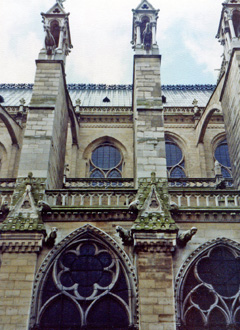 |
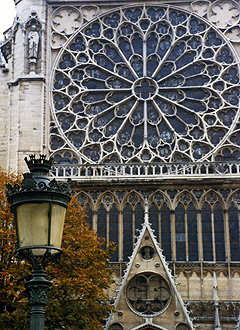 |
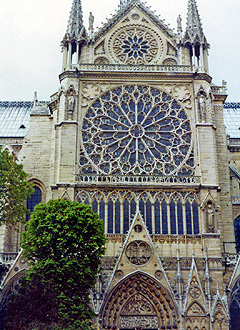 |
|
| A detailed view of the north side of the nave. | The rose window as seen from outside on the south trancept of the cathedral. | The glorious south trancept. |
 |
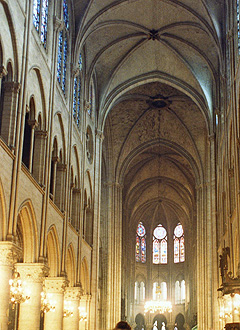 |
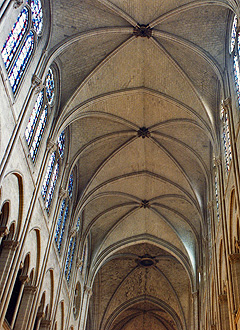 |
|
| The portal of the last judgment. | Inside a gothic cathedral such as Notre Dame your attention is draw upwards. | Here is the ceiling of the Notre Dame Cathedral of Paris. |
| Articles of French history:Eiffel tower, Paris Opera house, Louvre, Versailles | |
|